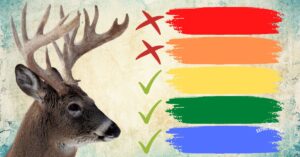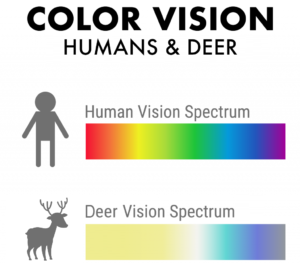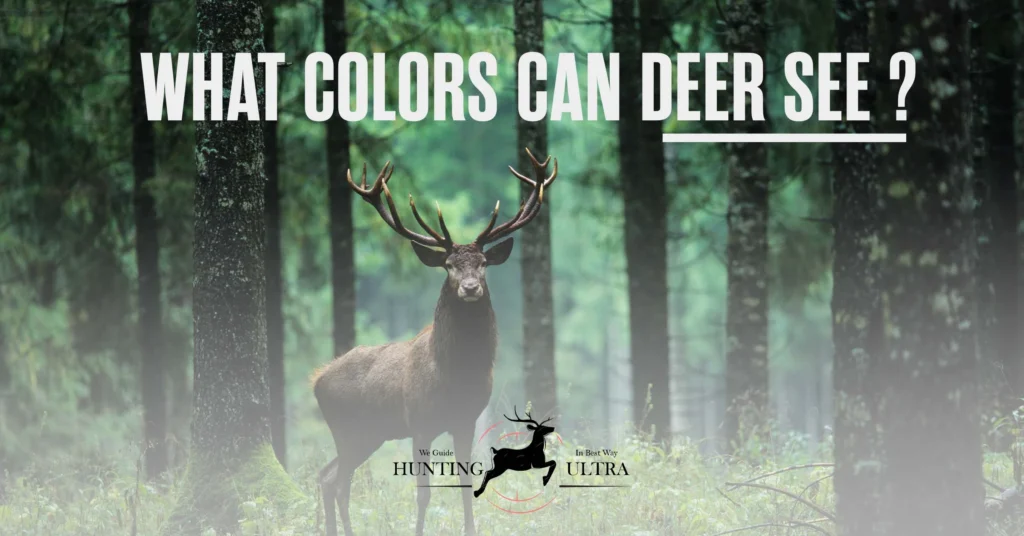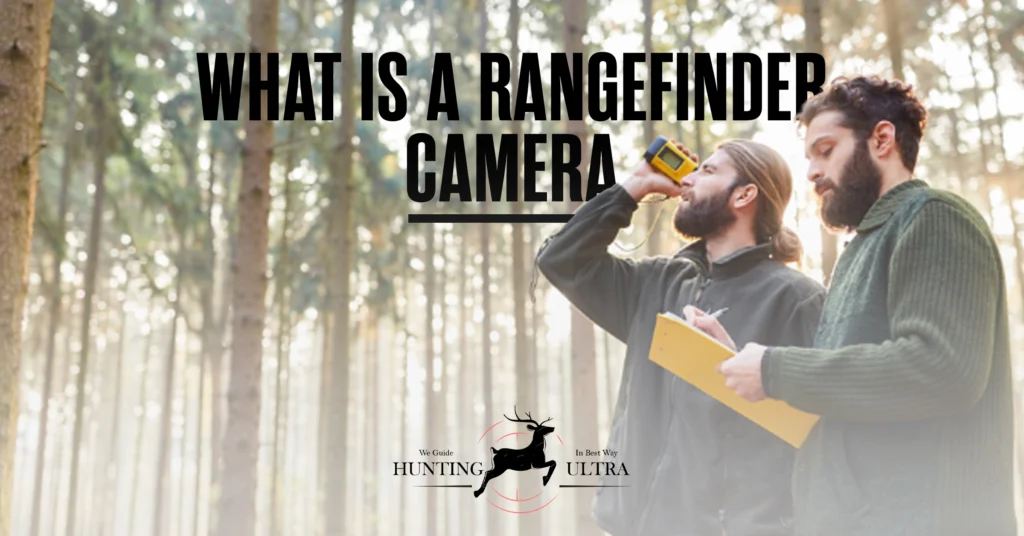Can deer see colors? or what colors can Deer see? This is a question that many people ask, as they are curious about the abilities of these animals. Deer have long been the subject of fascination for wildlife enthusiasts and hunters alike. Understanding their vision is essential for those who wish to observe these majestic animals in their natural habitat or engage in responsible hunting practices. To truly appreciate deer and their environment, it’s crucial to delve into the question of what colors they can see.
What Colors Can Deer See?

The answer to this question is not as simple as you might think. Deer see a different range of colors than we do, and their eyes are specially adapted to help them see in low-light conditions.
The World in Shades of Green
Deer primarily perceive the world through shades of green. They have a keen sensitivity to short-wavelength light, which is most prominent in the green part of the spectrum. This means that the lush foliage and vegetation that dominate their habitats appear vibrant and distinct to their eyes. Understanding this preference for green can provide valuable insights for hunters and wildlife photographers seeking to blend into the natural surroundings.
Limited Color Vision
While deer excel in detecting various shades of green, their color vision is somewhat limited compared to humans. They struggle to distinguish between certain colors, such as red and orange, which may appear as shades of gray or brown to them. This deficiency in their color vision can be advantageous for hunters, as it allows them to wear camouflage in these shades without being easily spotted.
Blue and Purple: A Mystery
One of the most intriguing aspects of deer vision is their perception of blue and purple. While there is some debate among experts, it is believed that deer can see these colors, although they may not perceive them as vividly as humans do. This unique ability to detect blue and purple may have evolved as a means of identifying edible berries or assessing the quality of foliage.
Ultraviolet Detection
Deer possess a remarkable ability to detect ultraviolet (UV) light, a part of the spectrum invisible to human eyes. This UV sensitivity aids them in detecting subtle cues in their environment, such as the presence of predators or the scent markings of other deer. It’s a crucial adaptation that contributes to their survival in the wild.
Can Deer See At Night?
Deer have very good eyesight, but they are not nocturnal animals. This means that they cannot see as well in the dark as some other animals can. However, their eyes are designed to work well in low-light conditions. This means they can see at night, but not as well as during the day.
What colors can deer see at night?
Deer see colors differently than humans do. They are equipped with two types of color receptors, called cones and rods. Cones help deer see color during the daytime, while rods allow them to see in low-light conditions.
Deer have very good night vision due to their large eyes and the high number of rods in their retinae. However, they cannot see colors at night because rods do not detect color. Instead, deer see shades of gray when it is dark outside.
What time of night is Deer most active?
The time of night when deer are most active can vary depending on the time of year and the specific region. In general, however, deer are most active at dawn and dusk. This is when they are most likely to be out feeding and moving around.
During the winter months, when days are shorter, deer may be active during the daytime as well as at night. In areas where there is a lot of human activity, such as near roads and trails, deer may be more active at night in order to avoid people.
Read out: When do Deer shed their Antlers?
Deer Vision Vs Human Vision

Deer vision is very different from human vision. Humans have three types of cones in their eyes, which allow them to see red, green, and blue light. Deer have only two types of cones, which allow them to see blue and ultraviolet light. This means that deer can’t see the colors red and green.
Deer also have a tapetum lucidum, which is a layer of reflective tissue behind the retina. This helps them to see in low-light conditions by reflecting light back through the retina a second time.
The combination of these two factors means that deer see the world in a very different way than humans do. They are able to see ultraviolet light, which we cannot see. This allows them to see things that we would miss, such as urine marks or reflective objects in the forest.
The Role of Color Perception in Deer Behavior
Understanding the colors that deer can see provides valuable insights into their behavior. The dominance of green hues in their visual spectrum is not merely a coincidence but a crucial adaptation. This preference for green allows deer to navigate and interpret their environment effectively. It influences their choice of habitat, feeding patterns, and even mating rituals. Hunters and wildlife enthusiasts alike can benefit from appreciating the role that color perception plays in the daily lives of these graceful creatures.
Beyond the Rainbow: Exploring Elk Vision
While elk share similarities with deer in their vision, delving into the specifics of elk color perception unveils its own unique characteristics. Elk likely perceive a spectrum of colors, akin to other mammals, yet there’s a lingering mystery surrounding the color red. Some experts propose that elk might lack the ability to see red, a limitation that could shape their interactions with the surrounding landscape. This nuanced understanding of elk vision adds an intriguing layer to the appreciation of these magnificent animals in the wild
What color light is best for deer hunting?
The short answer is that deer can see all colors, but some are better than others for hunting purposes. The color of light that is best for deer hunting is blue or green light. These colors are not as visible to deer as other colors, so they will not be able to see you as quickly. You should check out Best Low Light Rangefinder for Hunting if you are going for a hunt in low light conditions.
What Colors Do Elk See?
What colors do elk see? This is a question that many people have, as elk are such beautiful animals. While we cannot know for certain what colors elk see, we can make some educated guesses based on what we know about other animals’ vision.
Elk are likely to see colors similar to those seen by other mammals, including humans. This means that they probably see a range of colors from red to violet. However, some experts believe that elk may not be able to see the color red. This is because red light is at the lower end of the visible spectrum, and many animals do not have the ability to see this color.
While we cannot know for sure what colors elk see, we can be fairly certain that they see a wide range of colors. This is just one of the many things that make these majestic creatures so special.
Frequently Asked Questions
Here are some important questions related to Deer Vision:
-
What color is most visible to deer?
Deer have a heightened sensitivity to short-wavelength light, making shades of green most visible to them.
-
What colors do deer see best at night?
Deer have adapted to see better in low-light conditions during dawn and dusk. While they don’t see full color at night, they can detect shades of green and blue.
-
What color light scares deer?
Deer are sensitive to bright, white light, which can startle or scare them. It’s best to use low-intensity or red light when observing deer at night.
-
Can deer see UV light?
Yes, deer can see ultraviolet (UV) light. In fact, their vision is more sensitive to UV light than our own. This sensitivity helps them to better see urine markings left by other deer, which can contain important information about mating, health, and dominance hierarchies.
-
Can Deer see the color Orange?
Deer have very good eyesight and can see colors quite well. However, studies have shown that deer cannot see the color orange very well. This is because the color orange is at the lower end of the visible spectrum for deer. So, while deer can see other colors quite well, they may not be able to see the color orange as clearly as some other colors.
-
Can Deer See Green Light?
Deer can technically see the green light, they don’t see it as well as other colors. This means that if you’re using a green flashlight while hunting, the deer may be able to see it, but it’s not likely to be as bright or noticeable as other colors would be.
-
Can Deer See Black, White, and Gray Colors?
It is a common misconception that deer can only see in black and white. In fact, deer can see a wide range of colors, including black, white, and gray. Studies have shown that deer are particularly attuned to the color red, which helps them to spot predators and other dangers.
However, they are also able to see a variety of other colors, including shades of gray. So, if you’re wondering whether or not deer can see black, white, and gray colors, the answer is yes! -
Can deer see Camouflage?
Yes, deer can see camouflage, but they perceive it as patterns rather than distinct colors.
-
What colors can deer not see?
Deer struggle to see red and orange colors, often perceiving them as shades of gray or brown.
-
Can deer see Purple?
Yes, deer can see purple, but their perception of it may not be as vivid as humans’.
-
Can deer see White?
Yes, deer can see white.
-
Can deer see black clothing?
Yes, deer can see black clothing, but it may not stand out prominently in their vision.
Conclusion
In conclusion, understanding “What Colors Can Deer See” offers a fascinating glimpse into the world of these magnificent animals. Their unique visual abilities, shaped by millions of years of evolution, play a crucial role in their survival and behavior. Whether you’re a wildlife enthusiast, a photographer, or a hunter, knowing how deer perceive the world can enhance your appreciation of these graceful creatures.



